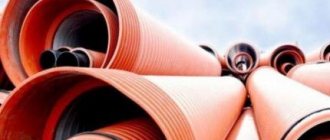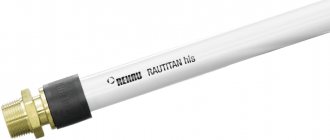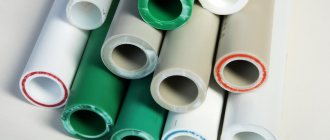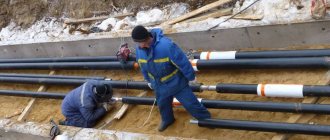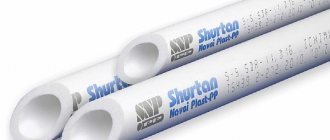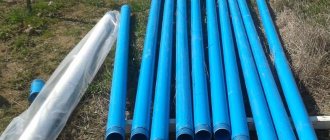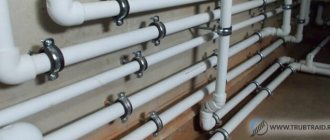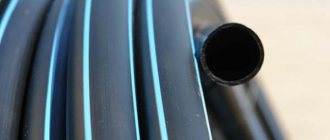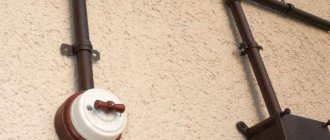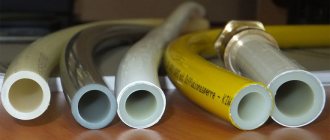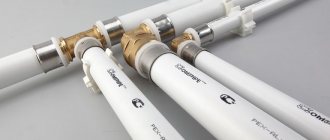Are you concerned about the arrangement of internal communications and the drainage system outside the house? Agree, it’s great when a country house has all the benefits of civilization, despite its remoteness from the metropolis.
But to build a system, you need sewer pipes for external sewerage, and you don’t know which ones are best to choose?
We will tell you which material is suitable for various operating conditions - the article discusses the characteristics of pipes made from existing materials, the advantages and disadvantages of each option.
There is also a rating of the best manufacturers of plastic and cast iron pipelines, selected photographs depicting their products and video recommendations from sewerage professionals.
Criterias of choice
The external pipeline operates in unfavorable street conditions. Incorrectly selected pipes for external sewerage can deform under soil pressure (during rising groundwater levels) or change properties due to severe frost. Violation of the integrity of the system will result in unexpected expenses for repairs (the damaged fragment will have to be replaced).
When designing external sewerage, they try to find a compromise between the need to ensure a long service life of the system and optimize costs. External sewerage pipes must meet the requirements for:
- strength (ability to withstand environmental stress);
- wear resistance (resistance to internal aggressive environment);
- affordability.
Scope of application
Today, uPVC sewer pipes for external sewerage can be seen in a variety of industries:
- public utilities - for repairs and installation of new sewer networks, organization of storm drainage;
- residential facilities - discharge of waste from apartment buildings and private buildings;
- agriculture – life support for livestock yards, production facilities;
- industry: hazardous waste disposal.
Sewage pipes for external networks can be installed as a continuation of the internal sewerage system made of uPVC, or combined with existing old communications made of cast iron, steel, and concrete. They are built into sections of the pipeline without loss of quality and even allow you to increase throughput by introducing smooth pipe sections that are not subject to overgrowth, which stimulates a natural increase in flow. Engineering solutions of any complexity can be implemented using uPVC, which is flexible in terms of installation: sockets, fittings, adapters, etc. can not only be combined with other materials, but are also made to order in cases where the technology requires it.
Types and characteristics
For external sewerage, several types of materials with different physical and chemical properties are used.
Cast iron pipes
A classic method of arranging a sewer system that has existed for decades. The widespread distribution of cast iron products was due to a complex of reasons:
- High mechanical strength and long service life.
- Resistant to temperature changes and aggressive environments.
- Easy installation.
Cast iron is expensive, heavy and efficient Source krasnodar.blizko.ru
With the development of technology, cast iron sewer pipes for external sewerage have lost relevance due to some features:
- Heavy weight, forcing the use of special equipment during assembly.
- A defect in the internal cavity, leading over time to a narrowing of the lumen.
Ceramic pipes
Ceramic pipelines have been known since antiquity. Modern factories produce ceramic products with a diameter of 100-600 mm, which have undoubted advantages:
- Service life 30-40 years.
- Easy installation and low installation cost.
- Chemical inertness, temperature stability and environmental friendliness.
- Low internal surface roughness.
Disadvantages of ceramic products:
- Fragility (before assembly they must be checked for cracks).
- Short length (increases the number of joints of external sewerage).
The fragility of ceramics is leveled by strict adherence to installation technology Source alemsohbet.co
Asbestos-cement pipes
Although the material contains asbestos fibers, their chemical bonding with cement makes the products safe. The advantages include:
- Light weight and easy installation.
- Durability.
- Low thermal conductivity (almost no problems with freezing).
- Resistance to aggressive environments.
The main disadvantage of asbestos-cement products is fragility. Mechanical loads (especially during transportation) are fraught with cracks and chipped edges.
Polypropylene pipes
Plastic polypropylene pipes (Russian name - PPR, international - PPR) are suitable for assembling an external sewer system in a country house. Their popularity is a consequence of their advantages:
- Long service life. Manufacturers guarantee 30-50 years of flawless operation.
- Light weight and elasticity. Savings on transportation and installation.
- Resistance to high temperatures (operating mode - 80°C; emergency short-term temperature of 100°C does not reduce service life).
Polypropylene - corrugated on the outside, smooth on the inside Source obustroeno.com
See also: Catalog of companies that specialize in water supply and sewerage.
- Chemical inertness. The material is resistant to corrosion and does not emit harmful substances.
- Smooth inner layer.
- Diversity. Selection of models and parts of any configuration. Options are available reinforced with fiberglass or aluminum.
Flaws.
- Products made from PPR cannot be bent. To organize bending or turning, tees and angles are used.
- A welding machine is used for connection. Thermal welding creates a seam that is uniform in structure.
Polyethylene pipes
The best sewer pipe manufacturers
Many foreign and domestic companies produce pipes made of various materials used for laying external sewers.
Place #1 - Dutch plastic manufacturer Wavin
The Wavin company, founded in Holland in 1955, specializes in the production of sewer and water plastic pipes. The company's products are in great demand throughout Europe.
The Dutch company Wavin is well known in European countries. The company offers a wide range of pipes and fittings for external sewerage
For outdoor use, the manufacturer produces Pragma corrugated polypropylene pipes, which have double walls, as well as other product options.
The Pragma components are 6 meters long; they are easily connected into a system, since they have a socket at one end and a rubber seal at the other. The manufacturer recommends using these products to create a network of external gravity sewerage.
Place #2 - international company POLIPLASTIC
POLYPLASTIC is an international company, whose divisions are located in the CIS countries (Russia, Kazakhstan, Belarus).
Among the range of branded products, a large place is occupied by all kinds of sewer elements, including external pipes made of various types of polymers (polyethylene, PAC, polypropylene, fiberglass).
The products produced by the company are characterized by an optimal combination of low weight with increased ring rigidity, due to which plastic pipes successfully resist even significant loads.
Reinforced products "Corsis Arm", included in the range of the POLIPLASTIC company, have a steel layer that enhances the rigidity of external sewer pipes
The signature line of this manufacturer is the Korsis series, which includes:
- two-layer corrugated products;
- spiral parts;
- multilayer reinforced pipes.
All these elements are perfect for laying external sewer networks and other drainage systems. The company produces products with a length of 600 or 1200 mm, a diameter of 110-600 mm.
Unlike other products, they have a corrugated black outer layer and an inner surface of light blue, yellow or orange.
Place #3 - German company Ostendorf
The famous German company Ostendorf Kunststoffe, which specializes in polymer pipes and other parts, was founded by the Ostendorf brothers in 1973.
Now the company is considered a leading manufacturer of elements of such systems in the specialized market. Products are supplied to many countries around the world, but the main consumer is Germany.
KG pipes (manufactured by the German company Ostendorf) have high consumer qualities. Such systems are durable, reliable, durable, and easy to operate.
In 2011, the Ostendorf plant began operating in Russia. The enterprise, where the latest technological equipment manufactured in Germany is installed, uses imported raw materials and components.
Strict quality control is organized in production, which is carried out in accordance with German and Russian standards.
Due to the highest quality of products, they are in high demand among consumers, despite their relative high cost.
The KG line, intended for external sewerage, is made of solid polyvinyl chloride without impurities, which has increased strength, water resistance, durability, and thermal conductivity.
The convenient shape of the ends allows for quick and easy installation of various systems.
Place #4 - domestic company Politek
Russian, founded in 1999, is a leader in the production of polymer products used for drainage, water supply, and sewerage.
The products of the domestic company Politek have gained popularity due to the optimal ratio of quality and price. Even budget products have decent characteristics
The company's factories have installed the latest foreign special equipment, which allows them to produce European-class products.
Place #5 - German cast iron manufacturer Duker
Although metal products are now less common than plastic ones, the demand for cast iron pipes can be called stable. Such products are produced by several European companies, among which the following can be noted.
Founded in 1913 in Karlstadt (Franconia, Germany), the company initially produced products with socket systems.
In 1968, innovative socketless pipes were developed, allowing parts to be shortened and the remaining trim to be installed using a combination method.
Now the company is the only manufacturer of cast iron sewer systems in Germany, and the plant carries out a completely completed production cycle: from casting to applying external coating.
The company offers a wide range of different systems with different lengths, diameters and connections. All of them have excellent consumer qualities: wear resistance, resistance to aggressive substances, strength.
Duker cast iron pipes are wear-resistant and their quality is excellent. In addition, thanks to the wide range, you can easily select pipes of the desired diameter
Place #6 - French company Saint-Gobain
The large concern Saint-Gobain (France) specializes in the production of modern cast iron products. For their manufacture, De Lavo technology (centrifugal casting) is used, followed by deep cooling of the structures.
Cast iron pipes, called Pam Global, are produced at the factories of a large French concern. During the production of products, the metal is coated with epoxy resin, zinc powder and acrylic varnish
Pam Global C systems are specifically designed for ground work, as well as the installation of high-quality, durable drainage systems. External sewer pipes have a diameter of 100-200 mm.
Video description
The plastic variety (Russian name - PE, international - PE), is widely used in external drainage systems:
PVC pipes
Polyvinyl chloride sewer pipes (PVC in international transcription) are mainly used for arranging sewer systems in residential buildings. Among the advantages of such products are:
- long-term operational period (40-50 years);
- reduced flammability and ultraviolet resistance;
- resistance to corrosion and clogging;
- light weight and easy installation (easy to cut and bend).
Smooth PVC pipes are used where there is no heavy load on the ground Source yandex.by
When using, it is necessary to take into account some features of the products:
- The disadvantage that limits the use of PVC pipes is the high coefficient of thermal expansion (change in linear size under the influence of temperature). If the liquid is heated to 60°C or higher, the tightness of the joints decreases, which can lead to leakage.
- The plasticity of the material decreases at low temperatures. Operation of the pipeline without insulation is allowed in the range from 0 to -15°C.
conclusions
For each of the listed materials, there was its own niche among the various sewer systems.
Thus, asbestos-cement pipes are mainly used where large diameters are required (over 600 mm), that is, in industrial and municipal drainage systems.
For such tasks, reinforced concrete pipes are also successfully used, the strength of which allows for high-pressure flushing of the system.
In a centralized network for an object such as a cottage community or a small enterprise, it is appropriate to use ceramics or cast iron.
For non-pressure (gravity) sewerage with a diameter of up to 210 mm, polymer pipes are most suitable.
HDPE pipes have high chemical and corrosion resistance, therefore they are durable. Let's look at the technical properties and application of HDPE pipes in more detail.
The technical characteristics and markings of metal-plastic pipes are described in detail in this article.
Advantages of sewerage with PVC pipes
The economic benefits of installing and using such a sewer system consist of:
- reducing transportation costs;
- saving consumables;
- low labor intensity during assembly;
- no operating costs.
Environmental safety during operation is also a valuable quality of products.
The appearance of PVC pipes has greatly simplified the organization of drainage Source remontsami.ru
Benefits of cooperation with Europlast
| Saving. We do not overpay intermediaries and set low prices for PVC sewer pipes. | Speed. Thanks to our large warehouse, we fulfill retail orders within 1-3 days after application. |
| Guaranteed quality. All products are certified and have a quality certificate. | Easy delivery. We deliver throughout Moscow and the region using our own transport. Are you in another region? We will send your purchase to a reliable shopping center. |
Extend the service life of your sewer pipeline without overpaying for brands and technologies. Order PVC pipes for sewerage in!
- Related products
- Additional products
- Similar products
External sewerage: sequence of work
- Preparing a trench for sewerage. Its depth depends on the depth of soil freezing, the occurrence of groundwater and other features of the site. According to SNiP P-G.3-62, laying is carried out 0.5 m below the freezing mark. For pipes with a diameter of 110 mm, the trench width is 0.6 m.
Checking the slope angle is an important part of installation Source oxu.az
- Pipeline installation. Starts from the foundation of the house; the pipes are connected in a suitable manner and laid with a slope. If the sewerage system is laid shallow, the pipeline is insulated. At the exit from the building, the pipe must be insulated.
- The slope angle is checked , then the trench is backfilled.
Check valve device
Improper installation and violation of the rules of operation of the drainage system leads to an emergency situation - a blockage. The contents of the pipes can move back with all the ensuing consequences on the 1st floor. Installing a sewer check valve helps avoid dramatic events.
A check valve allows fluid to flow only outward; the return flow of wastewater is reliably shut off. A valve with a diameter of 110 mm is mounted on a common pipe, and a valve with a diameter of 50 mm is mounted on each PVC drain pipe.
Valves are made from cast iron, brass or steel. Due to the widespread use of PVC pipes, the demand for cheap and durable PVC valves has increased. By design, check valves are:
- PVC valve. Mounted on both horizontal and vertical pipes. Inside there is a reciprocating locking part - a plate fixed at a slight angle. It bends under the pressure of the escaping liquid, and the reverse flow presses it, blocking the return movement.
- Ball valve. The locking mechanism is a metal ball. If back pressure occurs, it is pressed against the hole and blocks the flow.
Cross-section of a ball check valve Source aglant.ru
Installation features
To lay the external section of the system of a private house, a 110 mm plastic sewer pipe is usually used, the technical characteristics of which are quite suitable for this. Polyethylene pipes also have a good set of parameters, but their assembly requires special equipment.
The depth of the trenches must exceed the freezing level of the soil. If this cannot be ensured, the system will have to be insulated. For this purpose, a foam shell is used. A sand cushion is poured onto the bottom of the trench to act as a drainage layer. The laying of PVC pipes for external sewerage is carried out in compliance with all rules. A slope is created, for a diameter of 110 mm its value is 20 mm for each meter of length.
Additional sand backfill is poured over the insulation layer, after which the trench is filled with the excavated soil and thoroughly compacted. It is important to carefully make all connections, since after backfilling there will be no access to them. There is practically no opportunity to correct errors, since the full cycle of excavation work will have to be carried out again.
No. 5. Pressure and non-pressure sewer system
Pressure on pipes can be exerted not only from the outside, but also from the inside. Depending on how the drain is organized, the pressure will be different. There are non-pressure sewer systems , where wastewater moves by gravity. The sewage system in an apartment works in a similar way. Water drainage is also organized in a private house when the site is on a slope. Effluent moves through main sewer pipes under pressure. In a flat area, wastewater will also have to be forced to the septic tank. In this case, you cannot do without pressure equipment , the operation of which will subject the pipes to additional stress.
The type of sewer system affects the choice of PVC pipes:
- For non-pressure internal sewerage, pipes with a wall thickness of 1.8-3 mm are suitable; plasticized pipes are used. For non-pressure external sewerage, pipes with a wall thickness of 3.2 mm (for a diameter of 110 mm) to 12 mm (for a diameter of 500 mm) are taken;
- pipes for pressure sewerage made from unplasticized PVC. Such products, depending on the wall thickness, can withstand pressure of 0.8-1.6 MPa. Wall thickness varies from 2.2-6.6 mm for a pipe with a diameter of 90 mm to 12.3-23.9 mm for pipes with a diameter of 500 mm.
What other pipes are made from uPVC
There is no doubt that material with such properties is used not only for external sewer networks. We have already mentioned that pipes for indoor sewerage are also produced from it. By the way, they are no less common and are found both in apartments under the sink and in large industrial complexes, where they transport not only waste, but also product.
They can be used in pressure systems with water temperatures up to +450C, they are common in private construction when draining areas and constructing temporary and permanent sewer networks, they “work” on the movement of emulsified liquids and even gases.

